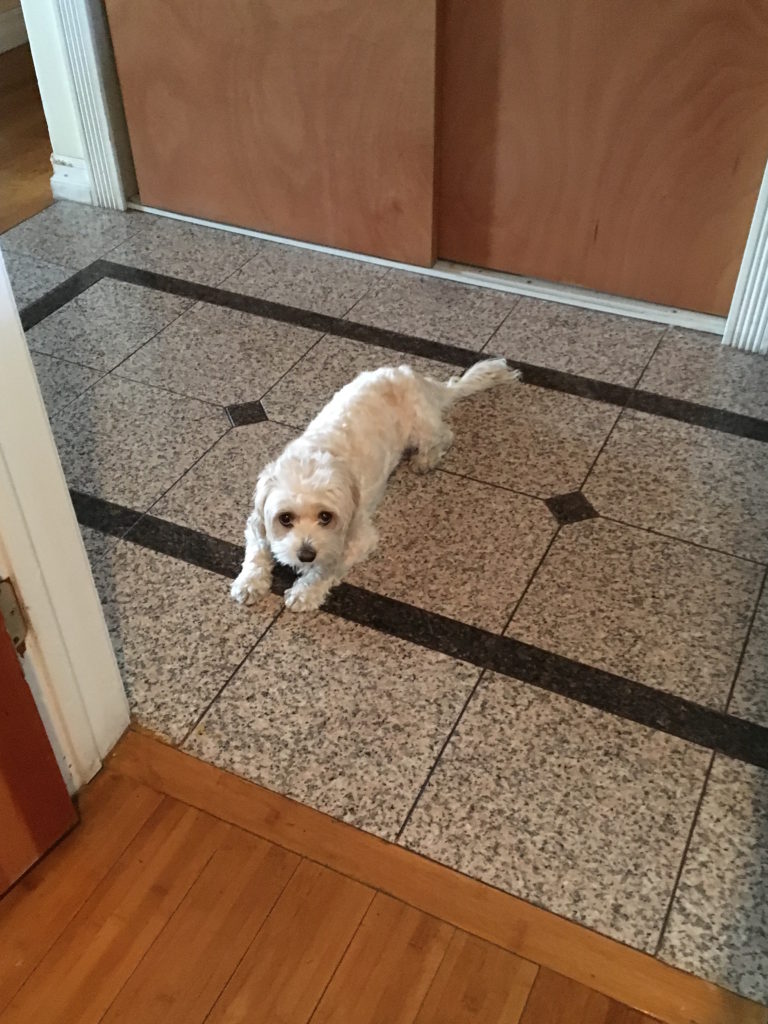Training a Pair of Shih Tzu Mixes to Respect Their Guardian to Stop Dog Barking
By: David Codr
Published Date: July 19, 2016
Luke (left) is a two-year-old Maltese / Shih Tzu / Cocker Spaniel mix who lives in Los Angeles with his sister Lola. Their guardians called me to schedule a dog obedience training session to stop dog barking, dog aggression, over excitement and fear of loud noises.
When I arrived for the session, Luke stayed behind Lola as both dogs approached the door barking. This was my first indication that Luke may be a little bit more insecure than Lola.
When we sat down in the living room to discuss the situation, Lola came up to investigate me where Luke stayed across the room barking quite a bit. I usually like to give a dog an opportunity to settle itself down by adopting some nonconfrontational body language and movement, but after a couple minutes it became clear Luke was not stopping anytime soon.
I pulled out a leash and handed it to his guardian so that she could place it on him and bring him over to me. Many dogs stop barking once a leash is attached to them. But in this case I wanted to accomplish more than simply stopping Luke’s barking.
By eliminating Luke’s ability to bark and then run away, I was forcing him to adopt a new behavior. As you can see in the video, this strategy worked very quickly. But if you use the technique, be sure to not try to engage with the dog until it relaxes.
This is a technique that I suggested Luke’s guardians repeat when they have other houseguests come over to visit. If necessary, arranging visitors to come by at a specified time can help the humans be prepared. It will likely take Luke a few to several more repetitions of this technique before he stops responding to visiting guests with his machine gun barking.
Now that Luke was settled down, I had an opportunity to discuss the dog’s day-to-day routine with their guardians. During this conversation I learned that the dogs did not really have many rules. This lack of structure can confuse a dog into thinking it has the same authority that the humans do. When a dog considers itself to have the same authority as the humans, then listening to the human’s commands and corrections becomes completely optional to the dog.
To help the dog’s guardian start to add a little bit of structure into their lives, I suggested a number of rules as well as how do enforce them. I also spent a couple of minutes going over a Manding technique that I have developed called Petting with a purpose.
By consistently asking the dogs to sit, lay down or come to them before they pet them, the guardians can get into a healthy habit that helps the dogs develop more respect for them as authority figures while simultaneously introducing the concept that praise must be earned, every time they pet them.
Because both dogs pulled on the leash to some extent, either out of excitement or due to the sight of another dog, I fitted both dogs up with a Martingale collar and showed the guardian how she can apply a special twist. This special adjustment of the leash will give her more control and stop them from pulling.
I suggested a couple of rules for a walk and then we headed out.
I recommended that the guardian start walking the dogs every day. These dogs are not in need of energy burn, but this walk and leash training is a great opportunity for the guardian to assume the leadership role in the dog’s eyes.
While we were on the walk I did get to observe Luke and Lola’s reaction to various stimuli; a man passing us on a bicycle, a vendor selling fruit on the corner, etc.
From what I saw, it appeared that the dogs were disagreeing with the presence of these people. This is likely a result of the dogs thinking that they have the same authority as humans, or potentially even more. The dogs are almost behaving as if they were the authority figures for the entire block. So when they saw someone they didn’t give permission to, they let the violator have it.
Adding rules and structure and correcting or rewarding the dogs within 3 seconds consistently will go a long way towards helping the dogs stop thinking that they have this authority. Once the dog stops identifying as a follower, then it will almost seem inappropriate to bark and disagree they way they do now.
To help the dogs learn to redirect their attention to their owner and focus on them, I spent a few minutes going over a technique that I Learned from Karen London’s book Feisty Fido, called the Watch.
It would be important for Luke and Lola’s guardian to practice this exercise with both dogs individually in the house without any other distractions. Once the dogs develop and refine their technique, then the guardian will be able to gradually introduce more distractions while practicing to make it more challenging.
Once the dogs can Watch on command inside amongst distractions, the guardian will be able to take the next step; exposing her dogs to other dogs in a controlled way so they can learn to adopt a new behavior.
The watch is a very effective technique as dogs can only think about one thing at a time. So if we train and condition the dogs to redirect their attention to us on command, we have the tools to stop a dog from getting over excited or fixating on something that is inappropriate.
But one of the things that I pride myself in doing is finding ways to incorporate structure into regular day-to-day events and activities. A good example of this is teaching the dog to keep a respectable distance from humans whenever they are eating food. Eating is a very primally important activity for dogs and simply being within 10 feet of a person or animal who is eating is extraordinarily rude or a challenge in the dog world.
The dogs family arranged a nice lunch meal in the living room so that we could use some of the escalating consequences I had shared with them earlier in the session. When disagreeing with the dog, it’s important that you do so with the right timing. If you’re too early or too late, it is difficult for the dog to understand what you were actually trying to communicate.
It was great to see how well the dog’s guardians took to these escalating consequences and the success she received when she applied them. I have found that showing a dog’s guardian what it is capable of can inspire them to take things even further.
Lola got the message loud and clear but it took a number of corrections before Luke started to figure it out on his end.
I regret not suggesting that the guardian look for a few tricks and commands on Youtube to teach her dogs. Learning new tricks and commands can help the dog’s develop more control and also increase their confidence. These are not nervous or anxious dogs, but they could use a little boost their self esteem. Mastering a few new tricks or commands can help instill some confidence that will help the dog feel less of a need to react to things it doesn’t know or understand.
By the end of the session, both dogs had adopted more of a follower’s mindset and were clearly more respectful of their guardians. They had stopped challenging the humans in the same demanding and persistent manner than they had before, were sitting or recalling much faster and were already respecting some of the rules and boundaries we had only just introduced.
About 15 minutes after leaving the session, the guardian texted me that when she returned to eating her lunch and neither dog even tried to get near her or the food – without any corrections needed. I received another text a few hours later showing me how Lola awaited outside of the kitchen as the guardian prepared their food. Prior to the session, the dogs would have been all over her. But that night, Lola only needed to be told twice before she laid down outside of the kitchen to wait.
For many of my clients, simply incorporating rules and structure in the house results in elimination of the dog reactivity outside of the house. If this is not the case then the watch exercise that we went through in the session will be something the guardian will need to practice and master in order to completely stop the dogs from reacting to things they see out on walks.
But based on the texts I received hours after the session, Im betting Luke and Lola’s days of barking at anything they saw have come to an end.
Categorized in: Dog Training



